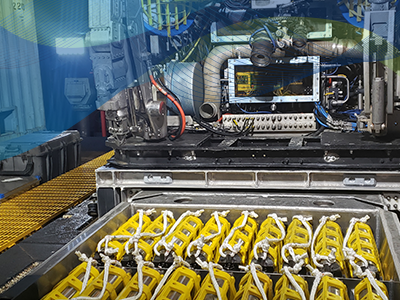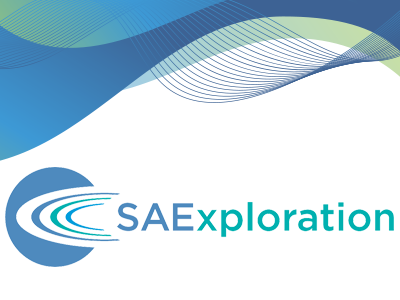NEWS
Geospace Technologies Reports Fiscal Year 2020 Second Quarter and Six-months Results
May 7, 2020 geospace
Company’s Subsidiary Quantum Technology Sciences Awarded U.S. Homeland Security Contract
Houston, Texas – May 7, 2020 – Geospace Technologies (NASDAQ: GEOS) (the “Company”) today announced a net loss of $11.8 million, or $0.87 per diluted share, on revenue of $25.9 million for its second quarter ended March 31, 2020. This compares with net income of $0.7 million, or $0.05 per diluted share, on revenues of $26.1 million for the second quarter of the prior year.
For the six months ended March 31, 2020, the Company recorded revenue of $51.6 million compared to revenue of $44.0 million during the prior-year period. The Company reported a net loss of $13.1 million, or $0.97 per diluted share compared to a net loss of $5.1 million, or $0.38 per diluted share for the prior-year period.
Walter R. (“Rick”) Wheeler, President and CEO of the Company said, “Given the full extent of health and economic devastation foisted upon the world by the COVID-19 pandemic, we are very thankful that our second quarter of fiscal year 2020 went about safely and with very little commercial disruption. Our employees continue to exhibit remarkable courage and ingenuity in preserving our ongoing operations as smoothly and efficiently as possible while maintaining strict safety. With their efforts we have secured our role as a critical manufacturer supplying customers in multiple sectors that are designated as critical infrastructure by the U.S. government.”
“Our second-quarter revenue was primarily fueled by ongoing demand for our ocean-bottom marine nodal recording systems. Total revenue of $25.9 million is relatively in line with our recent first quarter as well as last year’s second quarter, differing in both cases by less than 1%. However, gross profit in the second quarter of $7.9 million reflects a decrease compared to either of the prior mentioned periods. This is primarily due to costs for non-recurring upgrades made to our OBX rental fleet. Despite lower gross profit in the second quarter, the first six months of fiscal year 2020 reflect increases in revenue and gross profits of 17% and 37% respectively compared to the six months year-ago period. Note that the net losses reported for the three- and six-month periods ended March 31, 2020 are largely the result of a write-down to accounts receivable of $8.0 million in the second quarter for a doubtful account associated with one of our OBX rental customers. Due to the uncertainty of collection of revenue from this customer, our second quarter and six-month results exclude OBX rental revenue of $3.6 million and $5.1 million, respectively. Although our negotiations with the customer on financial instruments to secure payment of this debt continue, we intend to pursue full recuperation of this account.”
“Not included in reported revenue is the sale of a $12.5 million GCL land recording system, secured with a $10 million promissory note payable in 36 monthly installments. An initial deposit plus payments on the promissory note totaling $3 million have been received from the customer and recorded on our balance sheet within non-current deferred revenue. The customer is current on its note payments and we intend to recognize this revenue at a later date, when the collection of the promissory note is determined to be likely.”
Oil and Gas Markets Segment
For the three months ended March 31, 2020, revenue from the Company’s oil and gas markets segment totaled $18.4 million, a decrease of 1% compared to $18.7 million for the equivalent year-ago period. The slight reduction is the result of lower demand for the Company’s traditional sensors and marine products partially offset by an increase in demand for its OBX marine nodal systems. For the six months ended March 31, 2020, revenue from this segment totaled $37.9 million, an increase of 28% compared to $29.7 million in the six months ended March 31, 2019. The increase in revenue is primarily the result of growth in demand for rental of the Company’s OBX nodal marine systems, partially offset by decreases in demand for the Company’s traditional seismic land and marine products.
For the three- and six-month periods ended March 31, 2020, the Company’s traditional seismic products generated $2.0 million and $4.0 million respectively, reflecting decreases of 49% and 35% for the same respective periods one year ago. Demand for the Company’s traditional oil and gas seismic products had noticeably declined prior to the COVID-19 pandemic as a result of reduced levels of seismic exploration by oil and gas companies. Demand destruction for crude oil brought on by a global reaction to COVID-19, combined with crude oil oversupplies generated by the dispute between Saudi Arabia and Russia will likely have a further negative impact on the demand for these products.
For the three- and six-month periods ended March 31, 2020, the Company’s wireless seismic products produced revenue of $16.1 million and $33.0 million respectively. These figures represent approximate increases of 18% and 58% respectively when compared with $13.6 million and $20.9 million for the prior year-ago periods. For both the three- and six-month periods, the increases over last year stem from increased rentals of the Company’s OBX marine nodal recording systems. In response to the COVID-19 pandemic and coinciding oil price volatility, demand for the Company’s OBX equipment has experienced only a slight reduction. One short duration project that was to have occurred in the Company’s third fiscal quarter is known to have been indefinitely postponed, and future projects intending to utilize the Company’s OBX systems could also face risks of cancelation or delays. However, no other cancellations or major delays have been reported to date, and the Company continues receiving requests to quote on new rental contracts.
For the three- and six-month periods ended March 31, 2020, the Company’s reservoir seismic products produced revenue of $337,000 and $555,000 respectively. This reflects respective decreases of 68% and 72% when compared to revenue of $1.1 million and $2.0 million for the respective three- and six-month periods last year. The decrease in both periods is due to fewer sales and services of the Company’s borehole products. Management believes that truly significant opportunities for meaningful revenue from this product category reside in future contracts for permanent reservoir monitoring (PRM) systems. The Company also believes it has greatly increased the likelihood of receiving such PRM contracts by its acquisition of OptoSeis® fiber optic sensing technology combined with extensive engineering and manufacturing improvements made to both its electrical and optical PRM products. The Company is in open discussions with multiple clients interested in deploying PRM systems in the coming years. As a result of concerns over COVID-19, some clients have called for temporary interruptions in these discussions, while other discussions have remained unaffected.
Adjacent Markets Segment
For the three- and six-month periods ended March 31, 2020, revenue from the Company’s adjacent markets segment totaled $7.1 million and $13.2 million respectively. The figures represent a decrease of 2% and 5% for each respective period when compared with $7.3 million and $13.9 million for the similar periods one year ago. The decreases in both the three- and six-month periods were largely brought on by unexpected delays in the manufacture of certain imaging equipment. In addition, lower incidental sales of film products contributed to the decrease over the six-month period. The decreases in both periods were partially offset by higher sales of the Company’s water meter cable and connector products. Management strongly believes in its strategy to nurture and expand the Company’s adjacent market segment in order to provide sound and reliable means of generating stable revenue to offset the volatility associated with its oil and gas market segment. Commerce for certain customers of the Company’s graphic imaging products depends on attended events and gatherings which have been largely curtailed in an effort to combat the spread of COVID-19. This will likely result in lower demand for the Company’s related products so long as restrictions on such gatherings are in effect.
Emerging Markets Segment
For the three- and six-month periods ended March 31, 2020, the Company’s emerging markets segment generated revenue of $372,000 and $469,000 respectively. This compares with $46,000 and $134,000 in the equivalent three- and six-month periods a year ago. The increases in both periods are attributed to the sale of border and perimeter security products to a commercial customer. On April 6, 2020, the Company announced that its Quantum subsidiary was awarded a $10 million contract with U.S. Customs and Border Protection (CBP) U.S. Border Patrol to provide an advanced technology solution to the Department of Homeland Security. While significant revenue from the contract is not expected until the Company’s first quarter of fiscal year 2021, management believes this first contract validates its calculated rationale in acquiring Quantum as part of a key strategy to leverage the core competencies and technologies of both organizations into expanded and diversified markets. Management further believes the efficacy and value of this unique technology will open doors for many more opportunities.
Balance Sheet and Liquidity
Over the six months ended March 31, 2020, Geospace used $5.7 million of cash for investment activities. Uses of cash included (i) $5.2 million investment in its rental equipment primarily to expand its OBX rental fleet, and (ii) $2.8 million for additions to property, plant, and equipment. These uses were partially offset by (i) $2.1 million of proceeds for the sale of rental equipment, and (ii) $0.2 million of proceeds from the sale of property, plant, and equipment. As of March 31, 2020, the Company had $18.9 million in cash, cash equivalents, and maintained an additional borrowing availability of $14.9 million under its bank credit agreement with no borrowings outstanding. Thus, as of March 31, 2020, the Company’s total liquidity stood at $33.8 million. The Company additionally owns unencumbered property and real estate in both domestic and international locations.
As of March 31, 2020, the Company had $8.0 million of accounts receivable due from an international seismic marine customer that has rented a significant amount of marine nodal equipment from the Company. The Company has experienced cash collection difficulties with this customer throughout fiscal year 2019 and through the second quarter of fiscal year 2020 due to the customer’s inability to generate sufficient cash flows to pay its obligations in a timely manner. In late November 2019, the Company ceased recognizing revenue from this customer and expects to continue to do so until the customer exhibits its ability to routinely service its debts owed to the Company in the ordinary course of business. At March 31, 2020, the total debt owed by the customer to the Company is $14.0 million; however, the customer’s trade accounts receivable balance of $8.0 million on the Company’s balance sheet at March 31, 2020 excludes $6.0 million of unrecognized rental revenue and late payment penalties invoiced by the Company during the six months ended March 31, 2020. The Company has received cash payments in excess of $20 million from this customer beginning in fiscal year 2018.
The Company is currently evaluating an offer by the customer to exchange the customer’s debts owed to the Company for a financial instrument issued by the customer and secured by certain of its assets. The final terms and conditions of the debt instrument, the exchange, and other matters have not yet been determined, and the Company has no obligation to enter into such an exchange. The Company has significant concerns about the customer’s ability to settle the debts owed to the Company, as such the Company recorded a bad debt expense of $8.0 million in its second-quarter ended March 31, 2020, as discussed above.
Wheeler concluded, “The challenges thrust upon our industry by the COVID-19 pandemic and the initial dispute between Saudi Arabia and Russia are unprecedented, and each has contributed to the historic drop in worldwide oil prices seen in recent months. Despite this adversity, we are confident that in our belief we have taken steps, to expand into new markets, diversify our revenue streams, and maintain our steadfast commitment to strong financial discipline have helped us navigate these troubled times. The recent $10 million contract awarded to our Quantum subsidiary by the Department of U.S. Homeland Security is just one example that demonstrates our ability to successfully execute our strategy of diversifying our innovative technology products and the revenue we generate from them.”
“I’d like to thank all of our hard-working employees, valued clients, and loyal shareholders for their support through these very difficult and uncertain times. We have made good progress on a strategic course and I feel confident that our decisions have and will continue to position us favorably for the future.”
Conference Call Information
Geospace Technologies will host a conference call to review its fiscal year 2020 second-quarter financial results on May 8, 2020 at 10:00 a.m. Eastern Time (9 a.m. Central). Participants can access the call at (800) 894-5910 (US) or (785) 424-1052 (International). Please reference the conference ID: GEOSQ220 prior to the start of the conference call. A replay will be available for approximately 60 days and may be accessed through the Investor tab of our website at www.geospace.com.
About Geospace Technologies
Geospace principally designs and manufactures seismic instruments and equipment. These seismic products are marketed to the oil and gas industry and used to locate, characterize, and monitor hydrocarbon producing reservoirs. We also market our seismic products to other industries for vibration monitoring, border and perimeter security, and various geotechnical applications. We design and manufacture other products of a non-seismic nature, including water meter products, imaging equipment and offshore cables.
Forward-Looking Statements
This press release contains “forward-looking statements” within the meaning of Section 27A of the Securities Act of 1933, as amended, and Section 21E of the Securities Exchange Act of 1934, as amended. These forward-looking statements can be identified by terminology such as “may”, “will”, “should”, “could”, “intend”, “expect”, “plan”, “budget”, “forecast”, “anticipate”, “believe”, “estimate”, “predict”, “potential”, “continue”, “evaluating” or similar words. Statements that contain these words should be read carefully because they discuss our future expectations, contain projections of our future results of operations or of our financial position or state other forward-looking information. Examples of forward-looking statements include, among others, statements that we make regarding our expected operating results, the results and success of our transactions with Quantum and the OptoSeis® technology, the adoption and sale of our products in various geographic regions, potential tenders for PRM systems, future demand for OBX systems, the completion of new orders for channels of our GCL system, the fulfillment of customer payment obligations, the impact of the coronavirus (or COVID-19) pandemic, the Company’s ability to manage changes and the continued health or availability of management personnel, volatility and direction of oil prices, anticipated levels of capital expenditures and the sources of funding therefore, and our strategy for growth, product development, market position, financial results and the provision of accounting reserves. These forward-looking statements reflect our current judgment about future events and trends based on the information currently available to us. However, there will likely be events in the future that we are not able to predict or control. The factors listed under the caption “Risk Factors” and elsewhere in our most recent Annual Report on Form 10-K, which is on file with the Securities and Exchange Commission, as well as other cautionary language in any subsequent Quarterly Report on Form 10-Q, or in our other periodic reports, provide examples of risks, uncertainties and events that may cause our actual results to differ materially from the expectations we describe in our forward-looking statements. Such examples include, but are not limited to, the failure of the Quantum or OptoSeis® technology transactions to yield positive operating results, decreases in commodity price levels, including risks related to the recent collapse in oil prices, which could reduce demand for our products, the failure of our products to achieve market acceptance, despite substantial investment by us, our sensitivity to short term backlog, delayed or canceled customer orders, product obsolescence resulting from poor industry conditions or new technologies, bad debt write-offs associated with customer accounts, lack of further orders for our OBX systems, failure of our Quantum products to be adopted by the border and security perimeter market, infringement or failure to protect intellectual property. The occurrence of the events described in these risk factors and elsewhere in our most recent Annual Report on Form 10-K or in our other periodic reports could have a material adverse effect on our business, results of operations and financial position, and actual events and results of operations may vary materially from our current expectations. We assume no obligation to revise or update any forward-looking statement, whether written or oral, that we may make from time to time, whether as a result of new information, future developments or otherwise.








